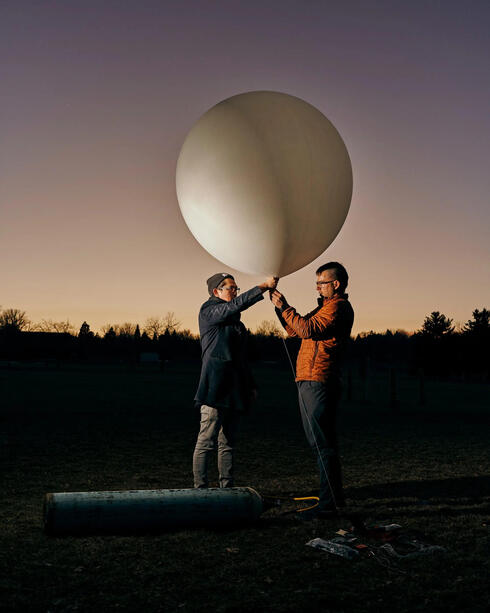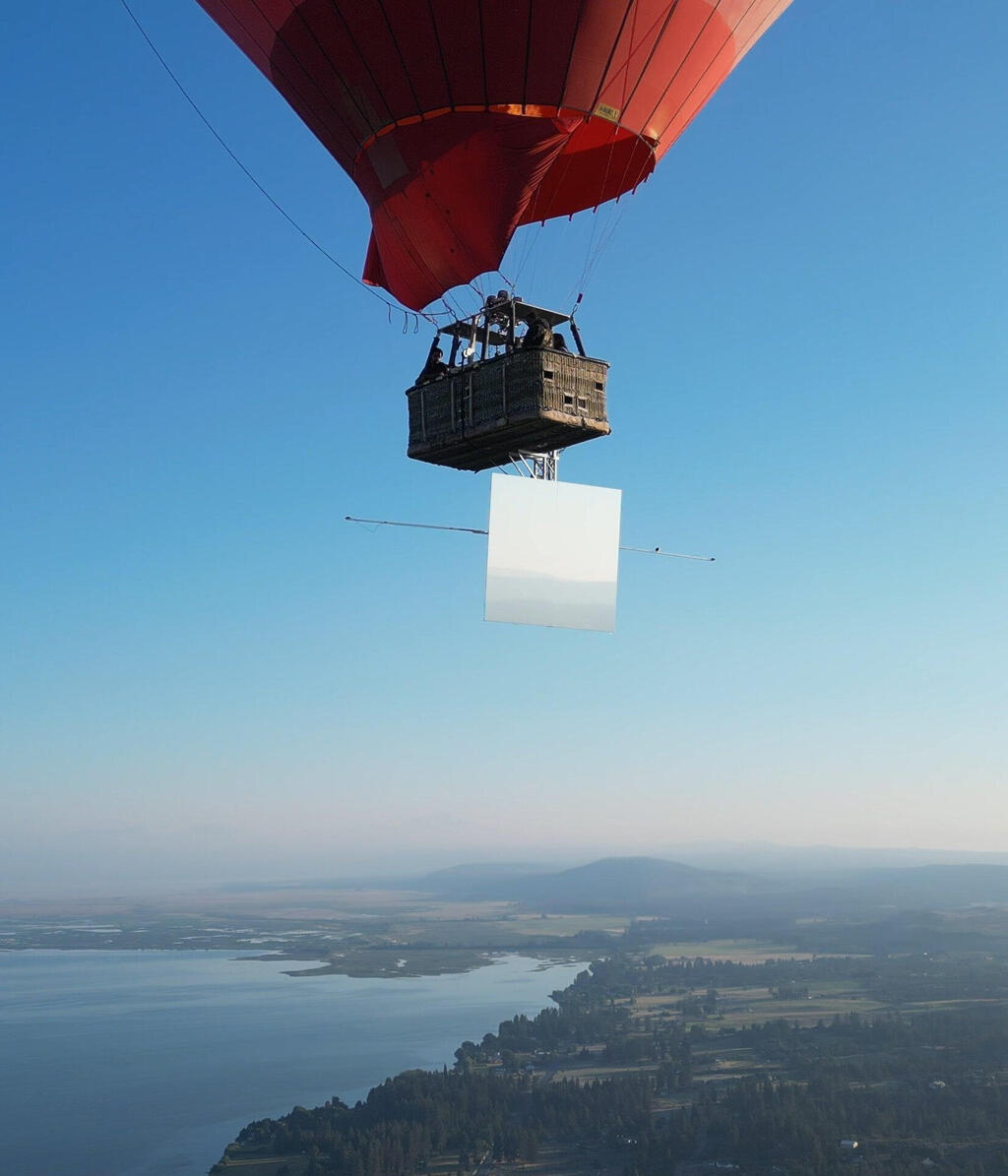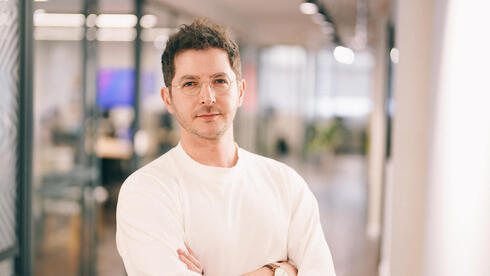
The heat is on: The rise of climate engineering ventures
Rampant climate change and record-breaking heat are pushing more and more fringe ideas in climate engineering to gain funding: from launching sulfur balloons to deploying satellites with mirrors to spraying chemicals into the atmosphere. However, in the absence of proper regulation, the lines between serious research bodies and reckless entrepreneurs are blurring, conspiracies are flourishing, and research critical to saving the planet may be stalled
In April 2022, Luke Iseman began releasing balloons filled with sulfur dioxide into the stratosphere—the middle layer of the atmosphere. The goal: to block sunlight, engineer the weather, and ultimately save the world from the climate crisis. What does it matter that Make Sunsets, the startup he founded that same year, is based on shaky science, that he has no experience in the field, or that Harvard University attempted to promote a similar solution for five years without success? The main thing is that the fight against global warming can already be translated into a source of income: for NIS 38 ($10), he sells one "cooling credit," which "offsets one ton of CO2 warming for a year," as stated on the company's website. But don’t worry, your purchase is "refundable at any time pre-deployment."
According to the company, it has raised $750,000, including from Boost VC and Pioneer Fund, and has so far launched dozens of balloons. However, there has been no evident significant impact on the climate. What the company did manage to do was anger Mexico, where Iseman conducted his first experiments. In January, Mexico banned the release of sulfur dioxide balloons from its territory, clarifying that Make Sunsets acted without notifying the authorities or obtaining their consent.
Iseman is not alone. Heat records are intensifying, and according to a June report by the Copernicus Climate Change Service, the average global temperature records have been repeatedly broken for 13 consecutive months. June was the third hottest month in recorded history, following July and August 2023. The failure of the international community to advance adequate solutions has resulted in more and more entrepreneurs playing God with the weather. Thus, fringe ideas in climate engineering are gaining approval and funding, bypassing the authorities on their way to the atmosphere.
But is it really a matter of necessity or a dangerous distraction, even if unintentional, from real, long-term solutions? Is it more dangerous to attempt these solutions or not to? And what about the damage caused by conspiracy theories about climate engineering, which are taking root among the public, and the politicians taking advantage of them?
No thought to consequences
Innovative solutions to slow down global warming are sometimes hastily promoted, to the extent that they don't take enough time to consider the possible consequences. For example, the American project Bright Ice Initiative aims to combat rising sea levels by covering glaciers with reflective materials, such as glass microspheres or tiny hollow bubbles, to delay their melting. However, the project has encountered opposition from indigenous groups in Alaska, who say that covering the ice harms wildlife.
Canadian startup Planetary Technologies, supported by Spotify and the winner of Elon Musk's XPRIZE for Carbon Removal, adds magnesium hydroxide to the ocean to reduce its acidity and restore its ability to absorb more of the carbon that humanity emits into the air. Similarly, the American Woods Hole Oceanographic Institute is dumping thousands of liters of sodium hydroxide into the sea. The problem is that there is no guarantee that these materials will dissolve properly, and along the way, they may also disrupt natural processes occurring on the ocean floor. After all, there is little research regarding how deep-sea creatures react to such interference.
There are also many contradictions across different climate engineering projects. For instance, the sub-field of solar radiation modification (SRM) includes a variety of creative ideas for injecting substances into the upper atmosphere that will reflect sunlight. A project at the University of Washington aims to operate a fleet of ships that will constantly spray tiny droplets of seawater into the air to increase cloud reflectivity, thereby blocking some of the sun's rays from reaching us.
The Cool Earth project, which the Technion is working on together with the UAE’s National Space Science and Technology Center and Israeli company ImageSat International (ISI), aims to place a giant sunshade in space—about the size of Argentina—to block a significant amount of solar radiation. The MEER organization, founded by a Harvard University researcher, wants to place mirrors on land and water surfaces and point them to the sky to bounce back sunlight.
Unlike these initiatives, California startup Reflect Orbital actually wants to increase the sunlight reaching Earth, using dozens of satellites with rotating mirrors that will be launched to an altitude of 600 kilometers and move from the North Pole to the South Pole and back. Its goal is to provide Earth with an additional 30 minutes of sunlight each day, increasing solar energy production. CEO and founder Ben Novak, a former SpaceX employee, plans to sell solar energy during dark hours and already offers early registration for those interested in "reserving sunlight."
So, should we reduce sunlight to mitigate climate change or increase it to provide more green energy? Without a supervising body to decide on the matter, there remains no conclusive answer. And, of course, some entities are causing real damage in their attempt to fix the problem. For example, oil company Occidental built a plant in Texas to create a vacuum that will suck massive amounts of air, remove carbon dioxide from it, and lock it deep underground in a process of extreme pressure that will solidify it.
The company promises to capture up to 500,000 tons of carbon dioxide this way and has already signed long-term contracts with Amazon, AT&T, and the Houston Astros. Unfortunately, in the process, oils and other polluting substances are produced. To compensate for this, Occidental has injected $1.1 billion into the startup Carbon Engineering, which has developed a way to absorb carbon dioxide from the air.
To act or not to act
When a startup fails, it shuts down, the founders move on to the next project, and the investors write off the investment, but when a climate engineering venture fails, weather patterns can be completely disrupted, border regions might experience widespread flooding or droughts, and billions of people could suffer. Given that we have only one Earth, the general anxiety over the "act now, apologize later" approach, which characterizes the tech sector, has not been well received positively.
Climate engineering has been practiced for nearly a century. As far back as the 1940s, many countries have engaged in cloud seeding - using aircrafts to disperse chemical substances, like hygroscopic salts, which accelerate the formation of water droplets. Israel was even considered a powerhouse in this field. However, there is still no scientific consensus on the effectiveness of the process, as it's difficult to determine whether rain occurred due to cloud seeding or natural processes. What is certain is that it’s a popular target for blame when the weather goes awry.
5 View gallery


A Reflect Orbital experiment to increase the sun's rays with rotating mirrors.
(Credit: Reflect Orbital)
This was the case last April when, in a single day, the UAE experienced an almost apocalyptic amount of rain that forced schools, offices, and businesses to close and turned Dubai's international airport into a small lake. On that day, an amount of rainfall equivalent to what typically falls in a year in the Arabian Peninsula - one of the driest regions in the world - was recorded. The frightened public blamed the prolonged cloud-seeding efforts of the state. Even though the more logical explanation is that extreme weather was caused by global warming, one can’t fault the Emirati public. After all, their government has been assuring them for years that cloud seeding can increase rainfall by 10-30%.
Meanwhile, SRM technologies have sparked campaigns to ban their use, like the Solar Geoengineering Non-Use Agreement. Why does this particular field attract so much attention? Perhaps because it’s the most frightening, perhaps because it’s popular in the tech sector, or perhaps because it was the basis for the dystopian plot of the successful book and film “Snowpiercer," in which a failed attempt to spray aerosols plunges Earth into an ice age.
Perhaps SRM triggers public anxiety because of a historical event: in 1991, Mount Pinatubo in the Philippines erupted and released 17 million tons of sulfur dioxide into the stratosphere. It’s estimated that the presence of these particles between the sun and the Earth's surface led to a global temperature drop of about half a degree Celsius for a year and created unusual weather patterns, which manifested, among other things, in severe flooding in Israel in 1992.
Make Sunsets and other researchers want to replicate this event with dozens of aircraft that will repeatedly spray chemicals into the stratosphere. The problem is not only that no one knows if such an effort will succeed, but also that no one has any idea how badly everything could go wrong. Nightmarish predictions include weather pattern disruptions, widespread floods or droughts, damage to the ozone layer, and harming food supplies by reducing sunlight for crops or reducing rainfall, or both. Even stopping the program could trigger a sudden temperature rise, preventing species and ecosystems from adapting. "If you think of climate engineering as experimental surgery, our findings suggest that the side effects of the treatment are as bad as the original disease," Nature Magazine wrote in 2018.
On the other hand, despite all the dire predictions, the UN's Environment Programme described SRM technologies in its latest report from February 2023 as the only way to cool the planet in the short term. In light of the rapidly deteriorating climate, this might be the best option available.
Don’t mess with the sun
The biggest problem with climate engineering is its disconcerting image. While there are rogue projects that grab headlines, there are also many reputable and mainstream research bodies that are genuinely trying to save humanity and are taking necessary precautions, but they get stuck trying to convince the public and scientific committees that their experiments are even legitimate.
For example, in 2017, researchers at Harvard University wanted to study how aerosols behave in the stratosphere. As part of the experiment, they planned to launch a balloon to a height of about 20 kilometers, releasing tiny particles of calcium carbonate - harmless chalk. The balloon was supposed to travel horizontally for about one kilometer, then make a U-turn through the chalk dust to detect the particles, measure how they change over time, how much sunlight they reflect etc.
5 View gallery


A cannon spraying sea water in Australia to increase the reflection of the clouds, thus blocking some of the sun's rays.
(Credit: Prof. Daniel Rosenfeld)
However, when the American media found out about the planned experiment, the headlines were sensational. "Harvard Plans to Block Out the Sun" was the popular headline most outlets used to describe the experiment. The massive public outcry forced Harvard to relocate the experiment, and only in 2020 did researchers receive approval from the Swedish Space Corporation to conduct the experiment in Sweden.
However, as soon as the news was published, a council representing the indigenous Sámi group wrote to the advisory committee, stating that the experiment was "a technology fraught with risks with potentially catastrophic consequences, including uncontrolled termination and irreversible socio-political effects... the direct opposite of the respect that indigenous peoples are taught to have for nature." The pressure worked, and the experiment was postponed.
In 2023, the lead researcher, David Keith, left the university and established a competing department at the University of Chicago. In March this year, Harvard announced that it was canceling the experiment without even launching a single tiny test balloon.
Are billionaires evil?
Harvard's climate engineering department was established with a grant from Microsoft founder Bill Gates. And he's not the only billionaire interested in blocking sunlight: George Soros funded a project to brighten the clouds over the Arctic region to slow down glacier melting; Jeff Bezos harnessed the computing power of Amazon, his retail giant, to simulate the potential effects of injecting sulfur dioxide into the atmosphere; and the two largest funders of climate engineering - SilverLining and the Open Philanthropy Project - are backed by Facebook co-founder Dustin Moskovitz, billionaire Rachel Pritzker, venture capitalist Bill Trenchard, and Steve Strongin from Goldman Sachs.
These big names might also explain the intensity of the backlash against scientific initiatives that are supposed to benefit humanity. After all, tensions between tech giants and states or multinational organizations have been at the heart of some of the biggest scandals in recent years, along with the conspiracy theories that followed, from interference in the U.S. elections in 2016, where Mark Zuckerberg was the main villain, to the COVID-19 crisis, which somehow, in the eyes of too many people, was seen as Bill Gates’ doing.
While tech companies certainly haven't done enough to provide the transparency needed to ease the tensions surrounding them, in their defense, no qualified national or international entity has stepped in to assess the risks or potential impacts of climate engineering. There's also no process in place for any regulatory bodies to evaluate which experiments are reasonable. As a result, anyone can throw whatever they want into the air - literally.
This isn't to say there haven't been attempts to regulate the field. Back in 2010, the UN's Convention on Biological Diversity established a global moratorium on large-scale climate engineering. But this is an outdated moratorium, using vague language, and it doesn't apply to small-scale experiments, like those of Make Sunsets. By the end of 2022, more than 500 researchers from 67 different countries signed an open letter calling for a global halt to climate engineering. In June 2023, the European Union called for a thorough analysis of the field's risks, stating that countries should discuss how to regulate the deployment of such technology.
The problem is that countries haven't been able to reach a consensus. For instance, in February, Switzerland proposed at the UN the creation of a scientific research group to examine technology for blocking sunlight. However, some African states feared that merely forming such a group would legitimize experimental methods and demanded that the resolution include a clarification that these methods would not be used. Due to the opposition, the proposal was rejected. Switzerland tried to pass a similar resolution in 2019 which also failed.
Following this, the head of the UN's Environment Programme issued a warning in March that experimental techniques to cool the atmosphere by partially blocking the sun are dangerous and could harm wildlife, oceans, the ozone layer, and crops. In other words, telling companies to be careful, but that no one would stop them if they conduct small experiments to alter the stratosphere. There remain no laws or international regulations on the matter.
Indeed, a month later, the University of Washington began an experiment in which aerosols were fired into the air from a cannon on a ship docked in San Francisco. The experiment, intentionally kept below the radar to temper public criticism, aimed to see how far the aerosols could travel outside the lab. Within a month the public became aware of the experiment and it was shut down by local inspectors. In June, the EU once again called for an international framework to manage climate engineering efforts, but this call also went unanswered.
‘Angels playing tic-tac-toe’
In such a situation, it's no surprise that conspiracy theories are rampant. Many are convinced that tech giants are trying to control the weather to damage crops, that governments are attempting to drug the masses, or that enemies of the state have launched a secret climate warfare campaign.
The conspiracies are so intense that just a month ago, the BBC published an article on climate engineering with an extraordinary disclosure, stating, that they had “seen a large increase in social media comments around geo-engineering since January, accusing us of covering up secret projects and wrongly blaming geo-engineering for the cool and wet weather we’ve recently had.” Around the same time, after the University of Washington's experiment was exposed, the White House issued a statement saying, “The U.S. government is not involved in the SRM experiment taking place in Alameda, CA, or anywhere else.”
Today, wherever there are conspiracy theories, there will be politicians who amplify them. In May, the State of Tennessee passed swift legislation, the first of its kind, banning any experiments related to climate engineering. Lawmakers in Illinois, Kentucky, Minnesota, New Hampshire, Pennsylvania, Rhode Island, and South Dakota are working to pass similar legislation.
One supporter of the legislation is Republican Senator Frank Niceley, who voiced opposition to climate engineering in open discussions due to fears of "chemtrails." This popular conspiracy theory suggests that the white trails (contrails) left by jet engines in the sky are not the result of water vapor condensation but rather chemicals sprayed by the government to control people's behavior or by “the enemy” as part of climate warfare.
"If you look up one day, it will be clear," Niceley said. “The next day they will look like some angels have been playing tic-tac-toe. They’re everywhere. I’ve got pictures on my phone with X's right over my house. For years they denied they were doing anything.”
“It’s conspiratorial nonsense,” said Justin Mankin, a climate scientist at Dartmouth College on Niceley's remarks. "Policymakers, instead of relying on science to appropriately debunk conspiratorial belief, have rendered it legitimacy through legislative action.”
















